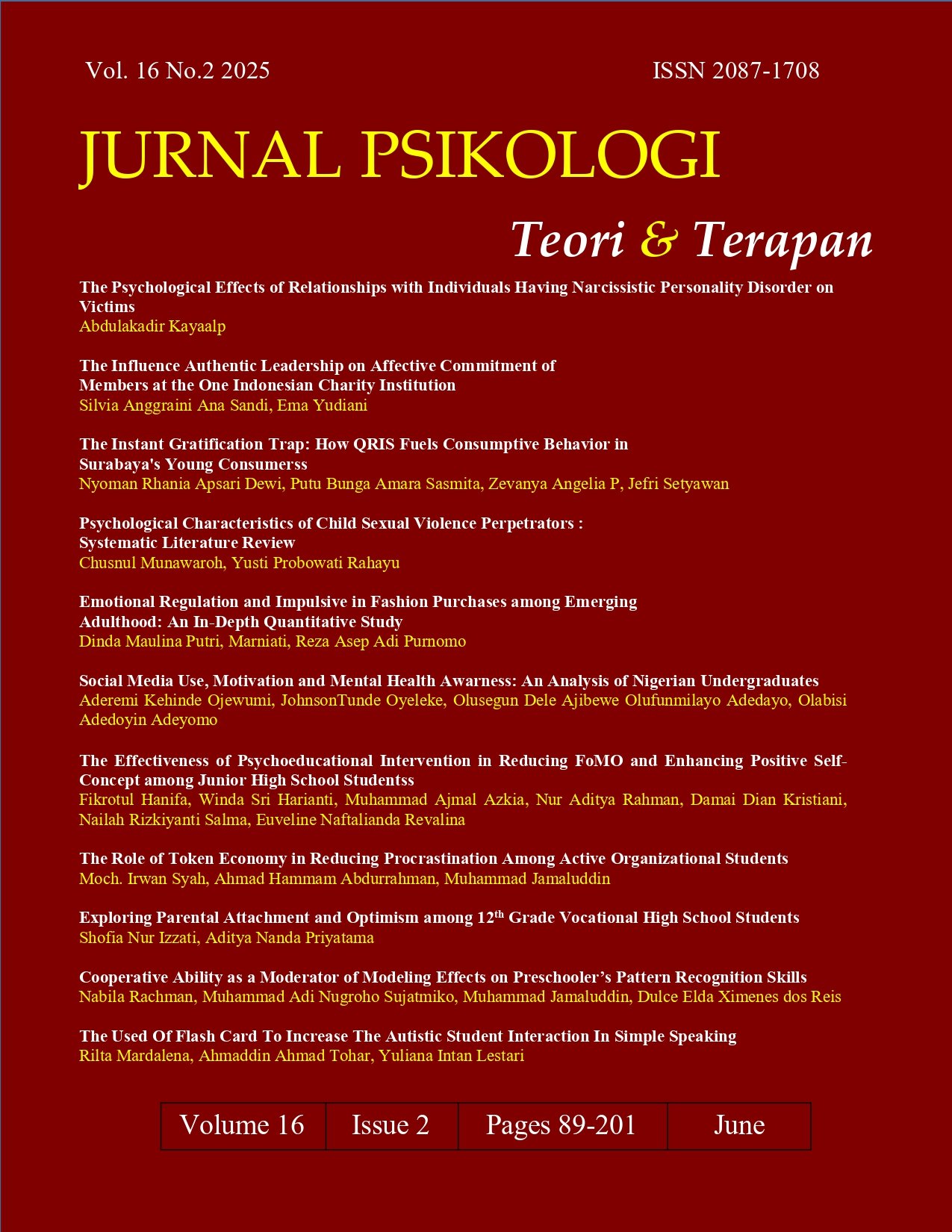Emotional Regulation and Impulsive in Fashion Purchases among Emerging Adulthood: An In-Depth Quantitative Study
DOI:
https://doi.org/10.26740/jptt.v16n02.p133-142Keywords:
Emerging adulthood, emotion regulation, fashion purchases, gender, impulsive buyingAbstract
Background: Emerging adulthood is characterized by self-image exploration and emotional instability, where insufficient emotion regulation may result in impulsive fashion purchases, highlighting a significant issue in this developmental phase. Objective: This research is to analyze emotion regulation and impulsive buying in fashion purchases in emerging adulthood. Method: The purposive sampling technique was used with 107 respondents, using emotion regulation scale and Impulsive Buying Tendency Scale to statistic test. The analysis was conducted using JASP version 0.19.3.0 with linear regression technique, moderation, and independent samples t-test at 5% significance level. Results: Emotional regulation has a negative effect with a value of (β = -0.267) on impulsive buying, and emotional regulation has a statistically significant difference on gender with a value of (p = 0.013), while impulsive buying has no different value on gender with a value of (p = 0.717). Finally, the value of (B = -0.543, p = 0.033) on gender moderation was obtained. Conclusion: The conclusion is that emotional regulation can reduce impulsive buying, with the same level of impulsivity between genders.
Abstrak
Latar Belakang: Emerging adulthood adalah masa yang penuh gejolak dan pencarian citra diri. Terkadang mereka tidak mampu meregulasi emosinya saat emosinya memburuk, sehingga memunculkan perilaku impulsive dalam pembelian busana. Tujuan: Penelitian ini untuk menganalisis regulasi emosi dan pembelian impulsive dalam pembelian busana pada emerging adulthood. Metode: Penelitian ini menggunakan purposive sampling. Data dikumpulkan dari 107 responden menggunakan skala regulasi emosi adaptasi Indonesian Emotion Regulation Questionnaire for Sport (IERQ4S) dan skala pembelian impulsif adaptasi dari Impulsive Buying Tendency Scale. Analisis dilakukan menggunakan JASP versi 0.19.3.0 dengan teknik regresi linier, uji moderasi, dan independent samples t-test pada taraf signifikansi 5%. Hasil: Berdasarkan uji statisik, regulasi emosi berpengaruh negatif dengan nilai (β = -0.267) terhadap impulsive buying. Selain itu, regulasi emosi memiliki nilai beda pada gender dengan nilai (p = 0.013), sedangkan impulsive buying tidak memiliki nilai beda pada gender dengan nilai (p = 0.717). Terakhir, didapatkan nilai (B = -0.543, p = 0.033) pada moderasi gender. Simpulan: Kesimpulannya regulasi emosi mampu menurunkan impulsive buying, dengan tingkat impulsive sama antar gender.
References
Aeron, S., & Rahman, Z. (2023). Discrete emotions effect on consumer evaluation and behaviour: A contextual perspective and directions for future research. Journal of Consumer Behaviour, 22(6), 1543–1573. https://doi.org/10.1002/CB.2243
Ahn, J., & Kwon, J. (2022). The role of trait and emotion in cruise customers’ impulsive buying behavior: an empirical study. Journal of Strategic Marketing, 30(3), 320–333. https://doi.org/10.1080/0965254X.2020.1810743
Badgaiyan, A. J., Verma, A., & Dixit, S. (2016). Impulsive buying tendency: Measuring important relationships with a new perspective and an indigenous scale. IIMB Management Review, 28(4), 186–199. https://doi.org/10.1016/j.iimb.2016.08.009
Baggio, S., Studer, J., Iglesias, K., Daeppen, J.-B., & Gmel, G. (2017). Emerging Adulthood: A Time of Changes in Psychosocial Well-Being. Evaluation & the Health Professions, 40(4), 383–400. https://doi.org/10.1177/0163278716663602
Brown, K. L., Lawson, K. M., & Banks, D. E. (2024). The Differential Role of Perceived Same-Gender and Gender-Neutral Norms in Emerging Adult Risk Behavior. Substance Use & Misuse, 59(4), 549–557. https://doi.org/10.1080/10826084.2023.2287214
Brown, V. (2024). Navigating identity formation via clothing during emerging adulthood. Journal of Fashion Marketing and Management: An International Journal, 28(2), 226–239. https://doi.org/10.1108/JFMM-01-2023-0019
Cavazos-Arroyo, J., & Máynez-Guaderrama, A. I. (2022). Antecedents of Online Impulse Buying: An Analysis of Gender and Centennials’ and Millennials’ Perspectives. Journal of Theoretical and Applied Electronic Commerce Research, 17(1), 122–137. https://doi.org/10.3390/jtaer17010007
Cengiz, H., & Barin, A. (2025). How does body appreciation affect maladaptive consumption through fashion clothing involvement? A multi-group analysis of gender. Journal of Fashion Marketing and Management: An International Journal, 29(1), 94–112. https://doi.org/10.1108/JFMM-08-2023-0200
Chauhan, S., Banerjee, R., & Dagar, V. (2023). Analysis of Impulse Buying Behaviour of Consumer During COVID-19: An Empirical Study. Millennial Asia, 14(2), 278–299. https://doi.org/10.1177/09763996211041215
Chetioui, Y., & El Bouzidi, L. (2023). An investigation of the nexus between online impulsive buying and cognitive dissonance among Gen Z shoppers: Are female shoppers different? Young Consumers, 24(4), 406–426. https://doi.org/10.1108/YC-06-2022-1548
Crocetti, E., Moscatelli, S., Van der Graaff, J., Rubini, M., Meeus, W., & Branje, S. (2016). The Interplay of Self–Certainty and Prosocial Development in the Transition from Late Adolescence to Emerging Adulthood. European Journal of Personality, 30(6), 594–607. https://doi.org/10.1002/per.2084
Delhom, I., Melendez, J. C., & Satorres, E. (2021). The regulation of emotions: Gender differences. European Psychiatry, 64(S1), S836–S836. https://doi.org/10.1192/j.eurpsy.2021.2209
Dirwan, D., & Latief, F. (2023). Understanding the Psychology Behind Consumer Behavior. Advances in Business & Industrial Marketing Research, 1(3), 117–129. https://doi.org/10.60079/abim.v1i3.201
Dorman Ilan, S., Shafir, R., Birk, J. L., Bonanno, G. A., & Sheppes, G. (2019). Monitoring in emotion regulation: behavioral decisions and neural consequences. Social Cognitive and Affective Neuroscience, 14(12), 1273–1283. https://doi.org/10.1093/scan/nsaa001
Fenton‐O’Creevy, M., Dibb, S., & Furnham, A. (2018). Antecedents and consequences of chronic impulsive buying: Can impulsive buying be understood as dysfunctional self‐regulation? Psychology & Marketing, 35(3), 175–188. https://doi.org/10.1002/mar.21078
Ho, H. C., & Awan, M. A. (2019). The Gender Effect on Consumer Attitudes Toward Payment Methods: The Case of Online Chinese Customers. Journal of Internet Commerce, 18(2), 141–169. https://doi.org/10.1080/15332861.2019.1584010
Jannah, M., Sholichah, I. F., & Widohardhono, R. (2023). Confirmatory factor analysis: skala regulasi emosi pada setting olahraga di Indonesia (IERQ4S). Jurnal Psikologi Teori Dan Terapan, 14(01), 153–160. https://doi.org/10.26740/jptt.v14n1.p153-16019
Kanwal, M., Burki, U., Ali, R., & Dahlstrom, R. (2022). Systematic review of gender differences and similarities in online consumers’ shopping behavior. Journal of Consumer Marketing, 39(1), 29–43. https://doi.org/10.1108/JCM-01-2021-4356
Kaufman, J. R., Armstrong, M., Maciarz, J., Palekar, N., Kim, J., Koppelmans, V., Welsh, R. C., Langenecker, S. A., & Weisenbach, S. L. (2023a). 31 Sex Differences in Emotion Regulation and Emotional Awareness in Middle Aged and Older Adults. Journal of the International Neuropsychological Society, 29(s1), 820–821. https://doi.org/10.1017/S1355617723010172
Kaufman, J. R., Armstrong, M., Maciarz, J., Palekar, N., Kim, J., Koppelmans, V., Welsh, R. C., Langenecker, S. A., & Weisenbach, S. L. (2023b). 31 Sex Differences in Emotion Regulation and Emotional Awareness in Middle Aged and Older Adults. Journal of the International Neuropsychological Society, 29(s1), 820–821. https://doi.org/10.1017/S1355617723010172
Kemp, E., Cowart, K., & Bui, M. (Myla). (2020). Promoting consumer well-being: Examining emotion regulation strategies in social advertising messages. Journal of Business Research, 112(March), 200–209. https://doi.org/10.1016/j.jbusres.2020.03.010
Lee, S. H., & Workman, J. E. (2018). Consumer tendency to regret, compulsive buying, gender, and fashion time-of-adoption groups. International Journal of Fashion Design, Technology and Education, 11(3), 265–276. https://doi.org/10.1080/17543266.2017.1423518
McRae, K., & Gross, J. J. (2020). Emotion regulation. Emotion, 20(1), 1–9. https://doi.org/10.1037/emo0000703
Mitchell, L. L., Lodi-Smith, J., Baranski, E. N., & Whitbourne, S. K. (2021). Implications of identity resolution in emerging adulthood for intimacy, generativity, and integrity across the adult lifespan. Psychology and Aging, 36(5), 545–556. https://doi.org/10.1037/pag0000537
Morawetz, C., Mohr, P. N. C., Heekeren, H. R., & Bode, S. (2019). The effect of emotion regulation on risk-taking and decision-related activity in prefrontal cortex. Social Cognitive and Affective Neuroscience, 14(10), 1109–1118. https://doi.org/10.1093/scan/nsz078
Paley, B., & Hajal, N. J. (2022). Conceptualizing Emotion Regulation and Coregulation as Family-Level Phenomena. Clinical Child and Family Psychology Review, 25(1), 19–43. https://doi.org/10.1007/s10567-022-00378-4
Pham, M. T., & Lee, L. (2019). Introduction to Special Issue: Consumer Emotions in the Marketplace. Journal of the Association for Consumer Research, 4(2), 98–101. https://doi.org/10.1086/702851
Purnomo, R. A. A., & Jannah, M. (2025). The role of emotional regulation in predicting psychological well-being among physical education teachers. Journal Sport Area, 10(1), 97–108. https://doi.org/10.25299/sportarea.2025.vol10(1).20023
Secapramana, L. V. H., Magdalena, G. J., & Yuwanto, L. (2021). Impulsive Buying, Post-purchase Regret, and Credit Card. Proceedings of the 2nd International Conference on Business and Management of Technology (ICONBMT 2020), 175, 5–10. https://doi.org/10.2991/aebmr.k.210510.002
Squires, S., & Ho, H. W. L. (2023). Generation Z’s perceptions and attitudes toward debt: a case study of young consumers in rural Michigan, USA. Young Consumers, 24(2), 133–148. https://doi.org/10.1108/YC-07-2022-1567
Velert-Jiménez, S., De-la-Barrera, U., Gil-Gómez, J. A., & Montoya-Castilla, I. (2025). Characteristics of Emerging Adulthood and Emotion Dysregulation for Predicting Well-Being: Contributions of Qualitative Comparative Analysis. Emerging Adulthood. https://doi.org/10.1177/21676968251316957/SUPPL_FILE/SJ-PDF-1-EAX-10.1177_21676968251316957.PDF
Wang, Y., Pan, J., Xu, Y., Luo, J., & Wu, Y. (2022). The Determinants of Impulsive Buying Behavior in Electronic Commerce. Sustainability, 14(12), 7500. https://doi.org/10.3390/su14127500
Weinberger, M. F., Zavisca, J. R., & Silva, J. M. (2017). Consuming for an Imagined Future: Middle-Class Consumer Lifestyle and Exploratory Experiences in the Transition to Adulthood. Journal of Consumer Research, 44(2), 332–360. https://doi.org/10.1093/jcr/ucx045
Wenhold, H., & Harrison, K. (2021). Emerging Adults and Gender Norms: Everyday Life Experiences, Media Perceptions, Attitudes, and Future Expectations. Gender Issues, 38(4), 420–437. https://doi.org/10.1007/s12147-020-09270-3
Downloads
Published
How to Cite
Issue
Section
License
Copyright (c) 2025 Dinda Maulina Putri, Marniati, Reza Asep Adi Purnomo

This work is licensed under a Creative Commons Attribution 4.0 International License.
Authors who publish in this journal agree to the following terms:
Copyright in any article is held by the author.
The author grants the journal, publication rights with the work simultaneously licensed under a Creative Commons Attribution License that allows others to share the work with an acknowledgment of the work's authorship and initial publication in this journal.
Authors may enter into separate, additional contractual arrangements for the non-exclusive distribution of the journal's published version of the work (e.g., posting it to an institutional repository or publishing it in a book), with an acknowledgment of its initial publication in this journal.
Authors are permitted and encouraged to post their work online (e.g., in an institutional repository or on their website) prior to and during the submission process, as this can lead to productive exchanges, as well as earlier and greater citation of published work.
 Abstract views: 627
,
Abstract views: 627
, PDF Downloads: 578
PDF Downloads: 578


















